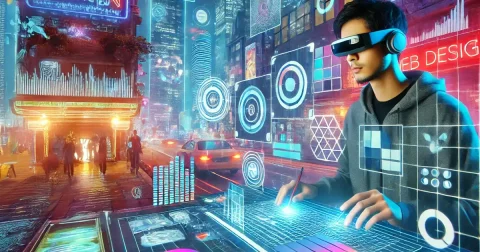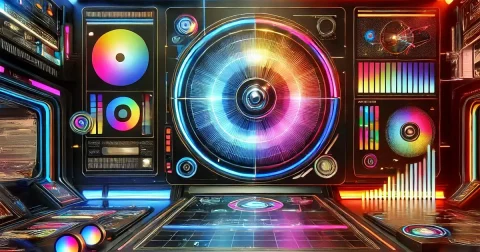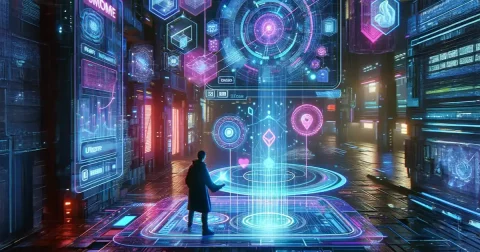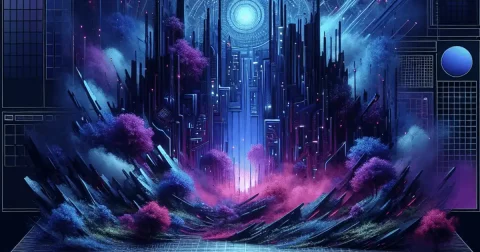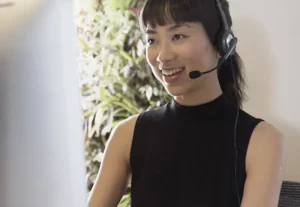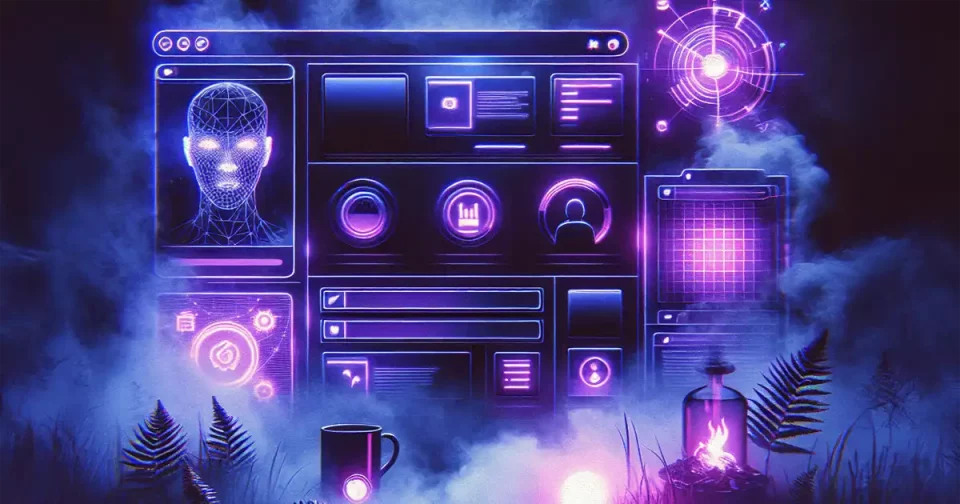
Web design is evolving rapidly, and businesses that fail to keep up risk looking outdated, losing engagement, and falling behind competitors. With users expecting seamless experiences, slow-loading pages, clunky navigation, or uninspiring designs can push visitors away—costing valuable conversions and credibility.
Staying ahead of 2025’s web design trends ensures websites remain visually striking, highly functional, and optimized for user experience. From AI-driven personalization to immersive 3D elements, the latest innovations will help brands engage audiences, enhance usability, and improve performance.
The Basics
Why Web Design Trends for 2025 Matter
Web design trends play a key role in shaping a business’s online presence. Keeping up with these trends is essential for business owners, marketers, and decision-makers looking to strengthen their digital footprint. Implementing the latest design innovations can improve user experience, boost engagement, and drive business growth. Learn more about optimizing websites with conversion rate optimization.
An effective website does more than attract visitors—it turns them into customers. With mobile devices accounting for nearly 60% of web traffic (BrowserStack), ensuring a site is mobile-friendly is now essential. Explore website optimization to improve performance across all devices.
How Modern Web Design Trends Shape the Industry
Modern web design trends influence industry standards and shape user expectations. Explore website care plans for long-term site maintenance. One of the most significant shifts is responsive web design, which ensures seamless user experiences across all devices. This approach leverages HTML, CSS, and JavaScript to dynamically adjust elements based on screen size, maintaining visual consistency and functionality (Ventura Web Design & Marketing).
Certain features, like dark mode, have gained widespread popularity, with 95% of users preferring it and 91.8% enabling it when available (DiviFlash). These preferences are influencing web designers and developers to incorporate high-contrast interfaces, reshaping design norms.
Engagement-driven features, such as microinteractions and animations, further highlight the impact of evolving trends. Studies indicate that micro animations can enhance user engagement by 20% (DiviFlash), making them a valuable tool for improving navigation and overall user experience.
Beyond engagement, modern trends are driving sustainable web design. You can read about best practices in SEO analytics. Efficiency-focused strategies minimize redundant website elements, leading to faster load times and a lower environmental impact.
Accessibility and usability enhancements also play a key role in web design evolution. With 66% of user attention now focused “below the fold,” optimizing scrollability and content hierarchy has become more critical than ever (DiviFlash).
By embracing these trends, businesses can ensure their website services remain competitive and effective. For more insights into modern design strategies, explore web design tools and best practices.
1. Minimalist & Clean UI
The Rise of Modern Web Design Trends
As web design continues to evolve, minimalist and clean UI remains a dominant trend. Prioritizing simplicity in UI/UX design enhances usability, boosts performance, and improves accessibility while maintaining a visually appealing aesthetic. By eliminating clutter and focusing on intuitive navigation, minimalist design creates a seamless and engaging user experience.
| Benefits of Minimalist & Clean UI | Description |
|---|---|
| Improved Usability | Simplified interfaces are easier for users to navigate and interact with. |
| Better Performance | Fewer elements and cleaner code can result in faster loading times. |
| Enhanced Aesthetics | Clean designs are visually appealing and timeless. |
| Improved Accessibility | Simplicity in design often translates to better accessibility for diverse users. |
Minimalist and clean UI is no longer just a passing trend; it has become a core principle of modern web design. Several key elements define this approach:
- Simplicity and Clean Aesthetics: Modern designs prioritize simplicity, resulting in visually appealing and clutter-free interfaces.
- Dark Mode Implementations: Widely adopted for its sleek appearance and reduced eye strain, especially in low-light environments.
- Bold and Vibrant Colors: Used to create contrast and draw attention to key elements, making interfaces more dynamic.
- Asymmetry in Layouts: Moving away from rigid structures, asymmetrical designs create visually engaging and unique layouts.
- Immersive Multimedia Elements: Incorporating videos, animations, and interactive features enhances user engagement and experience.
Many websites are also shifting from traditional photography to illustrations, a trend that improves loading speeds while offering more creative and customized visuals (Blue Compass). Illustrations effectively communicate complex ideas while making content more engaging.
Another emerging trend is monochromatic web design, which creates a sleek and simple look while making contrasting elements stand out.
Business owners, marketers, and decision-makers seeking professional web design services can apply these minimalist design principles to create intuitive and visually striking websites. Whether updating an existing site or starting from scratch, leveraging custom web design strategies ensures a unique and compelling digital presence.
For more web design inspiration and insights into the latest design strategies, explore expert resources designed to elevate online experiences.
2. AI-Driven Personalization
How New Web Design Trends 2025 Use AI
AI-driven personalization is redefining modern web design trends, allowing websites to create tailored experiences that resonate with users. Businesses and marketers are leveraging AI to refine user interactions, making digital strategies more engaging and effective.
By analyzing user behavior and preferences, AI can personalize content, recommend relevant products, and even adjust website layouts to improve the user experience. This adaptive approach not only enhances engagement and satisfaction but also streamlines the design process by automating real-time adjustments.
Key AI Personalization Features
- Behavior Analysis: AI tracks user interactions, including clicks, scrolls, and navigation patterns, to understand preferences.
- Content Curation: Dynamically suggests articles, products, or services based on browsing history and engagement.
- Dynamic Layouts: Adjusts the website interface to highlight the most relevant content for each visitor, optimizing usability.
As AI continues to evolve, machine learning in UX and behavioral targeting will play an even greater role in web design, making digital experiences more intuitive and personalized.
| Feature | Description | Benefit |
|---|---|---|
| Behavior Analysis | Tracks user interactions | Personalizes experience |
| Content Curation | Recommends relevant items | Increases engagement |
| Dynamic Layouts | Adapts interface in real-time | Enhances usability |
AI enhances web design by personalizing content and automating repetitive design tasks. By analyzing user feedback, AI-driven systems can refine layouts and functionality without requiring constant manual adjustments, resulting in more intuitive and user-friendly websites.
For deeper insights, exploring web design principles and custom web design strategies can provide valuable guidance.
AI-driven personalization is not just for large enterprises—small businesses can also leverage these technologies to enhance their digital presence. Implementing AI in web design for small businesses can improve customer retention and boost conversion rates by delivering more relevant, tailored experiences.
Embracing AI-driven personalization helps businesses maintain a competitive edge by ensuring their websites are not only visually appealing but also optimized for user engagement and functionality. For additional web design inspiration and innovative strategies, explore expert resources designed to elevate digital experiences.
3. Dark Mode & High-Contrast UI
Why Web Design Trends Current Favor Dark Mode
Dark mode has emerged as a leading trend in modern web design, featuring dark backgrounds with light text to enhance both aesthetics and functionality. A study by Polar found that 95% of users prefer dark mode, with 91.8% enabling it whenever available, highlighting its widespread appeal.
Several factors contribute to dark mode’s popularity:
- Aesthetic Appeal: Dark mode offers a sleek, modern look that enhances the user experience. Many users find dark themes easier to read and navigate.
- Battery Efficiency: On OLED screens, dark pixels consume less power, improving battery life—an advantage for users who spend significant time on mobile devices.
- Reduced Eye Strain: Dark mode minimizes eye strain in low-light environments, making browsing more comfortable, particularly at night.
- User Customization: Providing a dark mode option meets user expectations for a more personalized and adaptable design. The ability to toggle between light and dark themes improves accessibility and usability.
As virtual reality (VR) and augmented reality (AR) continue shaping digital experiences, dark mode is expected to play an even greater role. Its ability to complement immersive visual environments makes it a natural fit for next-generation web design (Lummi).
The table below summarizes user preferences for dark mode adoption.
| Preference | Percentage |
|---|---|
| Users preferring dark mode | 95% |
| Users using dark mode whenever available | 91.8% |
Data sourced from DiviFlash
Implementing dark mode is an effective way to align with current web design trends while catering to user preferences. Pairing this feature with responsive web design ensures a seamless experience across different devices, enhancing both accessibility and usability.
For deeper insights into modern web design strategies, explore responsive web design and web design tools. These resources provide valuable guidance for creating visually engaging and high-performing websites.
4. 3D & Immersive Elements
Enhancing UX with New Web Design Trends 2025
As web design continues to evolve, the use of 3D and immersive elements is becoming more prominent. These features create a more engaging and interactive experience, drawing users in and enhancing overall usability.
By incorporating advanced technologies like virtual reality (VR) and augmented reality (AR), immersive web design enables dynamic interactions. Users can explore 3D environments, engage with virtual products, and experience websites in more interactive ways. This trend is especially valuable for e-commerce, where virtual try-on features help customers make more informed purchasing decisions.
| Feature | Benefit | User Preference (%) |
|---|---|---|
| Interactive 3D Views | Higher Engagement | 82 |
| Virtual Product Interaction | Increased Conversions | 40 |
| Preference for 3D over Video | Enhanced Satisfaction | 95 |
Figures courtesy DiviFlash
Designers are prioritizing immersive experiences by combining visuals, audio, and interactive elements to engage users on a deeper level. This integrated approach enhances sensory engagement and strengthens the connection between users and digital products (ATAK Interactive).
Micro animations are expected to become even more widespread in 2025. These subtle movements bring websites to life, making interactions feel more dynamic and engaging. They are particularly useful for drawing attention to key areas of a page and improving navigation (Blue Compass).
Another growing trend is the shift from traditional photography to illustrations. With smaller file sizes, illustrations improve loading speeds while offering a creative way to communicate complex ideas. High-quality, custom illustrations capture user attention and enhance storytelling, making them a valuable asset in modern web design (Blue Compass).
For business owners, marketers, and decision-makers looking to stay ahead, integrating 3D and immersive elements is essential. These innovations not only improve user experience but also help websites stand out in an increasingly competitive online environment. For more insights on advanced web design strategies, explore resources on professional web design services.
5. Motion & Micro-Interactions
Motion and micro-interactions are key elements of modern web design, improving user engagement and creating more intuitive navigation. As businesses focus on delivering interactive and memorable experiences, these features are playing an increasingly vital role in website design.
How Modern Web Design Trends Improve Engagement
Micro-interactions introduce subtle yet meaningful enhancements to web design, improving user experience by making interfaces more dynamic and responsive. Beyond aesthetics, these interactive elements help guide users naturally through a website, offering real-time feedback that makes navigation smoother and more engaging.
Common Types of Micro-Interactions:
- Click and Tap Interactions: Small animations or visual cues that respond when users click or tap elements.
- Scrollbar Functionalities: Custom scrollbars that visually guide users as they move through content.
- Pull-to-Refresh Animations: Indicators that signal content is being refreshed.
- Swipe Effects: Smooth transitions that improve the browsing experience on mobile devices.
- Progress Bars: Visual cues that indicate loading times or form completion status.
- Call-to-Action Buttons: Highlighted buttons with animations to capture user attention.
- Notification Bells: Alerts that inform users of new messages or updates.
These micro-interactions are more than just decorative—they play a functional role in guiding users, enhancing accessibility, and improving real-time communication within a website.
| Micro-interaction Type | Examples |
|---|---|
| Click and Tap Interactions | Button animations, link highlights |
| Scrollbar Functionalities | Animated scrollbars, progress indicators |
| Pull-to-Refresh Animations | Spinner icons on refresh |
| Swipe Effects | Carousel transitions, menu swipes |
| Progress Bars | Form submission indicators |
| Call-to-Action Buttons | Hover effects, loading animations |
| Notification Bells | Message alerts, update notifications |
Micro animations are expected to become even more prevalent in 2025, adding movement that enhances user engagement and creates a lasting impression on visitors (Blue Compass). These subtle animations help highlight key areas of a page and direct user attention, making interactions more intuitive and engaging.
When used effectively, motion and micro-interactions can make web pages more dynamic and enjoyable, improving overall user experience.
Understanding the finer details of web design and development and leveraging the right web design tools can help businesses integrate these trends seamlessly.
6. Voice UI & Conversational Interfaces
Voice User Interfaces (VUIs) and conversational interfaces are shaping modern web design, offering a more intuitive and hands-free way for users to interact with websites. By reducing the need for typing or clicking, these technologies create smoother and more accessible experiences. Their importance continues to grow, especially for businesses focused on improving user engagement and ensuring greater inclusivity.
The Role of AI in Web Design Trends for 2025
Artificial Intelligence (AI) is driving significant advancements in web design trends for 2025, particularly in voice and conversational interfaces. AI-powered solutions enable more personalized user experiences while automating design processes, making web development more efficient and adaptable.
Benefits of Voice UI & Conversational Interfaces
- Increased Accessibility: Voice interfaces provide hands-free interaction, making digital platforms more accessible for users with disabilities or mobility limitations.
- Improved User Engagement: By offering a more natural and intuitive way to navigate websites and applications, voice interfaces enhance user interaction and retention.
- Personalization: AI-driven technologies adapt to individual user preferences, delivering customized experiences that improve satisfaction and usability.
- Efficiency: Automating repetitive design tasks allows designers to focus on more complex aspects of development, streamlining workflows and improving productivity.
As AI continues to evolve, integrating voice search optimization and conversational interfaces into web design will further enhance accessibility, engagement, and overall functionality.
| Feature | Benefit |
|---|---|
| Hands-Free Interaction | Increased Accessibility |
| Natural Language Commands | Improved User Engagement |
| Personalized User Experiences | Increased Satisfaction |
| Automation of Design Tasks | Enhanced Efficiency for Designers |
Key Technologies in Voice UI
- Natural Language Processing (NLP): Enhances the ability to interpret and process human language, enabling more accurate voice commands.
- Machine Learning: Allows systems to learn from user interactions and refine responses for a more personalized experience.
- Speech Recognition: Converts spoken words into text, enabling seamless voice-based interactions with websites and applications.
For businesses looking to enhance voice search compatibility, SEO management services can provide valuable expertise.
Incorporating these innovations into a web design strategy can set a business apart by enhancing accessibility, usability, and engagement. For inspiration and best practices on modern web design, explore Authority Pilot’s academy resources.
By staying ahead of these advancements, businesses can exceed user expectations, leading to stronger engagement and higher satisfaction.
7. Sustainability & Eco-Friendly Design
How New Web Design Trends 2025 Focus on Efficiency
As awareness of environmental sustainability grows, web design trends for 2025 are adapting by prioritizing eco-friendly practices. This shift focuses on reducing the environmental impact of websites through strategies such as faster loading speeds, energy-efficient hosting, and long-lasting design choices (Lummi). These sustainable approaches not only benefit the environment but also improve website performance and user experience.
The Role of Sustainable Web Design
Sustainable web design emphasizes efficiency and environmental responsibility. Designers are now factoring in energy consumption, server demands, and the durability of design elements to create more sustainable websites. By optimizing these aspects, they aim to minimize the carbon footprint of online platforms while enhancing functionality and user satisfaction.
| Aspect | Description | Benefits |
|---|---|---|
| Faster Loading Times | Efficient coding and image compression to speed up page loads | Enhances user experience and reduces server energy consumption |
| Eco-Friendly Hosting | Utilizing data centers powered by renewable energy sources | Reduces carbon emissions associated with web hosting |
| Longevity of Design | Creating timeless and adaptable design elements | Minimizes the need for frequent redesigns, reducing overall resource use |
Eco-Friendly Hosting Solution
Eco-friendly hosting is becoming a fundamental aspect of modern web design, with more companies choosing servers powered by renewable energy. This shift not only reduces environmental impact but also appeals to eco-conscious consumers. Businesses specializing in web design for small businesses can strengthen their market appeal by promoting sustainable hosting solutions.
Enhancing Efficiency Through Sustainable Design
Prioritizing sustainability naturally leads to more efficient web design practices. Clean, responsive coding improves loading speeds and minimizes data consumption, benefiting both the environment and user experience. This approach creates a win-win scenario, where optimized performance enhances usability while reducing digital waste.
Key Elements of Efficient, Sustainable Web Design
- Minimalist UI: Reduces unnecessary elements, improving performance.
- Optimized Image and Media Files: Compressing assets ensures faster load times.
- Caching Strategies: Minimizes repeated server requests for better efficiency.
- Responsive Design: Enhances accessibility and performance across all devices.
For expert guidance on sustainable and high-performing websites, visit website optimization.
Advantages of Eco-Friendly Web Design
Sustainable web design offers more than just environmental benefits:
- Improved User Satisfaction: Faster, more responsive websites enhance the browsing experience.
- Enhanced Performance: Efficient design principles contribute to better functionality and reliability.
- Reduced Costs: Optimized coding lowers server usage, cutting hosting expenses.
The web design trends for 2025 emphasize eco-friendly, efficient practices that reduce environmental impact while improving user experience. By adopting sustainable design strategies, businesses can stay competitive and create more engaging, responsible digital experiences.
8. Advanced Accessibility Features
Ensuring Inclusivity with Modern Web Design Trends
Ensuring an inclusive digital experience is a key focus in modern web design. Incorporating advanced accessibility features means designers can develop more inclusive, user-friendly websites. More can be learned about this via Authority Pilot’s website care plans. The approach improves engagement, broadens user adoption, and aligns with regulations such as the Americans with Disabilities Act in the United States (ATAK Interactive).
Essential Accessibility Features
- Screen Reader Compatibility: Optimizing website elements for screen readers allows visually impaired users to navigate content effectively.
- Keyboard Navigation: Enhancing websites for keyboard-only users ensures accessibility for individuals who cannot use a mouse.
- High Contrast Modes: Offering high-contrast color schemes improves readability for users with visual impairments.
- Alternative Text for Images: Descriptive alt text helps screen readers convey image content to visually impaired users.
- Voice UI Integration: Implementing voice-based interfaces provides hands-free navigation, benefiting users with mobility challenges (ATAK Interactive).
Advancing Accessibility with AI
AI and machine learning are transforming accessibility by automating the detection and correction of design barriers. These technologies adapt in real-time to individual user needs, creating a more seamless and inclusive browsing experience (Lummi).
For a deeper understanding of how accessibility is shaping modern web experiences, explore best practices in web design principles and responsive web design.
| Accessibility Feature | Adoption Rate (%) |
|---|---|
| Screen Reader Compatibility | 78 |
| Keyboard Navigation | 65 |
| High Contrast Modes | 54 |
| Alternative Text for Images | 82 |
| Voice UI Integration | 60 |
Legal and Ethical Considerations:
Meeting accessibility standards is both a legal obligation and an ethical commitment. Ensuring that all users have equal access to information and services fosters inclusivity and demonstrates a company’s dedication to social responsibility.
By incorporating advanced accessibility features, designers can develop more inclusive, user-friendly websites that accommodate a diverse audience. Prioritizing accessibility not only enhances the user experience but also ensures websites remain adaptable and aligned with custom web design and professional web design services.
9. Neumorphism & Glassmorphism
How Web Design Trends Current Are Evolving
Web design trends continue to evolve, with Neumorphism and Glassmorphism emerging as two of the most visually striking styles. These approaches not only enhance aesthetics but also contribute to a more engaging and immersive user experience.
Neumorphism
Neumorphism blends modern design with skeuomorphism, creating soft, extruded elements that appear to emerge from the background, giving a subtle 3D effect. This style relies on delicate shadows and highlights to add depth and realism, making interfaces feel more tactile and intuitive.
Key Features of Neumorphism:
- Soft Shadows and Highlights: Creates a sense of depth and enhances user interaction.
- Monochromatic Color Schemes: Uses variations of a single color to maintain a cohesive look.
- Minimalist Elements: Focuses on clean, uncluttered components for a sleek and intuitive interface.
Glassmorphism
Inspired by frosted glass effects, Glassmorphism emphasizes transparency, blur, and depth to create an airy, modern aesthetic. This trend has gained popularity in contemporary UI design for its ability to create sleek and sophisticated interfaces.
Key Features of Glassmorphism:
- Transparent Layers: Frosted glass effects add depth and dimension to the interface.
- Blur Effects: Softens background elements while maintaining visual separation.
- Vibrant Backgrounds: Enhances contrast and highlights interactive elements.
Both of these styles are redefining web design by introducing visually rich and interactive experiences. As designers continue to experiment with these trends, they offer new ways to enhance user engagement and create modern, polished interfaces.
| Feature | Neumorphism | Glassmorphism |
|---|---|---|
| Color Scheme | Monochromatic | Vibrant |
| Depth Creation | Soft shadows & highlights | Transparent layers |
| Visual Effect | 3D extruded elements | Frosted glass appearance |
| User Experience | Intuitive and tactile | Sleek and immersive |
Application in Modern Web Design
Neumorphism and Glassmorphism are valuable design approaches for custom web design, offering a balance of aesthetics and functionality. These styles create clean, focused interfaces that enhance usability and adapt seamlessly across devices, supporting responsive web design.
Successfully implementing these trends requires thoughtful execution to prevent overwhelming users with excessive visual effects. By integrating Neumorphism and Glassmorphism strategically, designers can craft innovative, user-friendly experiences that set websites apart in a competitive online landscape.
For inspiration on incorporating these styles effectively, explore web design inspiration. For expert guidance in applying these trends, consider professional web design services.
Conclusion
Key Takeaways from Web Design Trends for 2025
Web design trends are constantly evolving, making it essential for business owners, marketers, and decision-makers to stay informed. Here are the key trends shaping web design in 2025:
- Minimalist & Clean UI: A focus on simplicity and intuitive navigation reduces cognitive load and improves user experience.
- AI-Driven Personalization: AI-powered experiences enhance engagement and retention by delivering tailored interactions.
- Dark Mode & High-Contrast UI: Dark mode continues to gain popularity for its aesthetic appeal and improved readability, particularly in low-light environments.
- 3D & Immersive Elements: The use of 3D visuals and immersive design enhances engagement and creates more interactive experiences.
- Motion & Micro-Interactions: Subtle animations and microinteractions improve user engagement by guiding behavior intuitively.
- Voice UI & Conversational Interfaces: The rise of smart devices is making voice interfaces more common, enabling more natural and accessible interactions.
- Sustainability & Eco-Friendly Design: A greater emphasis on sustainable practices is driving more efficient, environmentally responsible web design.
- Advanced Accessibility Features: Prioritizing accessibility ensures inclusivity, making websites usable for a wider audience.
- Neumorphism & Glassmorphism: These modern design styles add depth and realism, blending aesthetics with functionality.
Staying ahead of these trends helps businesses build high-performing websites. Explore strategies in SEO ranking factors.
Be Current with Modern Web Design Trends
Keeping up with web design trends requires ongoing learning and adaptability. To maintain a competitive and user-friendly website, consider these key strategies:
- Frequent Updates: Regularly refresh your website to align with the latest design trends, ensuring a modern and engaging experience.
- Leverage the Right Tools: Utilize web design tools that support emerging trends and technologies, making design implementation more efficient.
- Prioritize Responsiveness: A fully responsive website enhances user experience across all devices.
- Embrace Innovation: Experimenting with new styles and design elements can help your website stand out and attract more visitors.
- Seek Professional Support: Partnering with web design services ensures a polished and high-performing online presence.
By implementing these strategies and staying informed about evolving web design trends, businesses can create visually appealing, user-friendly, and efficient websites. Adapting to these shifts strengthens digital strategies and helps maintain a competitive edge in web development.



